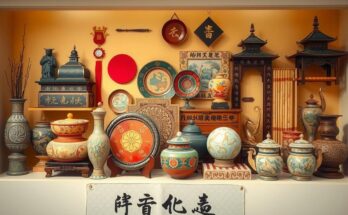Yunmeng County in Hubei, despite being the smallest in the province, is leveraging its vast cultural relics to enhance tourism. With over 5,000 artifacts, including ancient bamboo slips revealing early Chinese laws, Yunmeng blends preservation and innovation in arts like shadow puppetry. The county’s efforts in creating exhibitions and training local artisans are transforming it into a vibrant cultural destination.
Nestled in Central China’s Hubei province, Yunmeng County might be the smallest in the region, but it stands as a vibrant epicenter of rich cultural heritage and relics. With more than 5,000 historical artifacts—including national treasures—Yunmeng has embarked on a unique journey to harness cultural tourism through innovative preservation methods. This initiative includes establishing a research station for the protection of relics, revamping traditional art forms like shadow puppetry, and developing tourism projects that weave the region’s rich past into its visitors’ experiences. In a serendipitous archaeological discovery in late 1975, twelve tombs dating back to the Warring States and Qin Dynasties were unearthed, revealing treasures like over 1,000 meticulously recorded bamboo slips that chronicle the unification of the seven states. These slips, documenting legal codes and administration, unveil the sophistication of China’s ancient legal framework and its cultural narrative. To date, Yunmeng County boasts 36 first-class cultural relics, making it a sought-after destination for archaeologists and historians alike. The Yunmeng County Museum, with its impressive collection of relics, including priceless lacquerware and ancient wooden artifacts, serves as a beacon of heritage preservation. The museum is actively involved in restoring these treasures using modern techniques while training locals in artifact conservation, thus ensuring that historical craftsmanship is not just preserved but rejuvenated. Innovations extend into the performing arts, where local artists are reinvigorating traditional practices. Inspired performances like “ink dance of Qin bamboo slips” encapsulate historical narratives through vibrant choreography and storytelling, instantly captivating audiences. In the realm of shadow puppetry, master artist Qin Ligang merges tradition with technology, adding a modern twist with the help of an intelligent robot—a testament to creativity transcending time. By hosting exhibitions and creating memorial parks dedicated to their cultural lineage, Yunmeng is not only safeguarding its heritage but also transforming it into a thriving tourist attraction, offering visitors a feast for the senses. With its deep-rooted cultural wealth and artistic flair, this ancient county is rediscovering its identity and radiating newfound charm, enticing travelers with a timeless allure.
Yunmeng County, famed for its archaeological wealth, stands as a testament to China’s illustrious history. Despite its size, it is rich with over 5,000 artifacts—including many from the ancient regimes—making it a treasure trove for researchers and tourists alike. The unearthed items provide invaluable insights into early Chinese civilization, particularly regarding governance and legal systems, enriching our understanding of the past. The recent efforts to integrate these relics into cultural tourism is a strategic endeavor to not just preserve, but also celebrate and share the local heritage more broadly.
Yunmeng County’s commitment to intertwining cultural preservation with tourism is not merely a nod to its illustrious history but a dynamic approach to cultural revitalization. By cultivating local talent in traditional arts and establishing robust conservation practices, Yunmeng is ensuring that its rich heritage not only survives but thrives. As it continues to unveil and celebrate its past, this small county is poised to attract both history buffs and cultural enthusiasts, showcasing the timeless appeal embedded in every artifact and performance.
Original Source: en.antaranews.com



